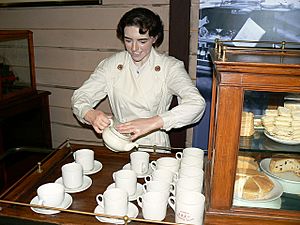Tea lady facts for kids
A tea lady is someone who brings drinks like tea or coffee to people at work. This job started in Britain during World War II and still exists in hospitals today. It used to be a common job for women and was often shown in movies and TV shows.
Contents
A Look Back: Tea Ladies in History
Tea ladies became popular in the UK during World War II. They were part of a plan to help workers feel better and work more efficiently. This was important for the war effort.
Their presence made a big difference to how people felt at work. They helped improve morale, which means how happy and confident people feel. Because of this, tea ladies became common everywhere. They even served soldiers with mobile canteens during training.
You might find them in a workplace cafeteria. Or they would come around with a trolley. This trolley usually had a large container called a tea urn. It was full of hot tea or hot water. They often had tasty cakes and buns too!
Why the Tea Lady Job Changed
The role of the tea lady started to disappear in the late 1970s and early 1980s. Businesses grew and began to use private catering companies. Also, vending machines became very popular.
At the same time, more women started working in different kinds of jobs. The tradition of the tea break, where the tea lady role began, also became less common. These changes helped explain why tea ladies are not seen as often today.
Tea Ladies Today

Tea ladies still work in the National Health Service (NHS) in Britain. However, the job of "tea attendant" is no longer just for women. Men can do it too.
Some hospital tea trolleys are run by the Royal Voluntary Service. Patients often say how much they appreciate the tea ladies. They feel that their care made staying in the hospital much easier.
Tea Ladies in Movies and TV
In the past, tea ladies were often shown in British comedy. They were usually portrayed as busy, middle-aged women in a uniform and cap.
In Australia, there was a TV show called The Tea Ladies. It aired in 1978.
Tea ladies were sometimes mentioned in the British TV show Yes Minister. The character Sir Humphrey Appleby would often suggest cutting their jobs. A tea lady was only seen once in the show. She shared a lift with other characters in an episode called "The Skeleton in the Cupboard" (1982).
The 2003 film Love Actually also featured a tea lady. The character played by Martine McCutcheon worked as a tea lady at 10 Downing Street.


